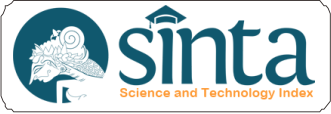A Paradigm Shift of English Lecturers to Support Education Technology in Online Learning
Abstract
The critical ability of English lecturers to education technology 4.0 could change the role of the traditional English lecturer because there needed to be a balance between soft skills and technological competencies. The value of digital transformation had shown that pedagogical interventions with student-centered pedagogy could design learning support goals and strategies and critically evaluate English lecturers’ self-management as professional trainers. The objectives of this study were to examine: (1) the role and innovation of English lecturers in the face of the paradigm shift in online learning, and (2) the conditions of digital learning related to lecturers` competencies. Focusing on qualitative data collected from 23 English lecturers at some higher education institutions in Indonesia, the results of English lecturer responses showed that the lecturers’ digital skills enhanced the following factors, such as knowledge, the students’ responsiveness to tasks, contextualized teaching and learning, and the stimulating of ideas as feedback thereby assisting the universities in recognizing the value of technology as their teaching needs. The data responses could reflect how the lecturers transformed learning through innovative pedagogical concepts and the use of digital in the classroom. Future research could strengthen the pedagogical profile for education 4.0 to master technology with a global view of world culture.
References
Apriani, E., & Hidayah, J. (2019). The ICT Used by the English Lecturers for Non English Study Program Students at STAIN Curup. Vision: Journal for Language and Foreign Language Learning, 8(1), 26-37. doi: 10.21580/vjv8i13280
Barclay, V. C., Smieszek, T., He, J., Cao, G., & Rainey, J. J. (2014). Positive network assortativity of influenza vaccination at a high school: Implications for outbreak risk and herd immunity. PloS one, 9(2), e87042. doi: 10.1371/journal.pone.0087042
Basar, T. & Sahin, L. (2022). Technology integration in teaching English as a foreign language: A content analysis study. Journal of Educational Technology and Online Learning , 5(1) , 204-222 . doi: 10.31681/jetol.972577
Bhat, R., Singh, V. K., Naik, N., Kamath, C. R., Mulimani, P., & Kulkarni, N. (2020). Covid-19 2019 outbreak: The disappointment in Indian teachers. Asian Journal of Psychiatry, 50, 102047. doi: 10.1016/j.ajp.2020.102047
Brown, K., Toombs, M., Nasir, B., Kisely, S., Ranmuthugala, G., Brennan-Olsen, S. L., Nicholson, G. C., Gill, N. S., Hayman, N. S., Kondalsamy-Chennakesavan, S., & Hides, L. (2020). How can mobile applications support suicide prevention gatekeepers in australian indigenous communities? Social Science & Medicine, 258, 113015. doi:10.1016/j.socscimed.2020.113015
Drath, R., & Horch, A. (2014). Industrie 4.0: Hit or Hype?. IEEE Industrial Electronics Magazine, 8(2), 56-58. https://doi.org/10.1109/MIE.2014.2312079
Effendy, A. A., Sudarso, A. P., Nurhadi, A., Arifianto, C. F., & Kartono. (2020). Peningkatan profesionalisme guru dan pengembangan sdm dalam menghadapi era revolusi industri 4.0 pada guru smk mulia buana parung panjang bogor. Abdi Laksana: Jurnal Pengabdian Kepada Masyarakat, 1(2), 198–204.
Florian, L. (2017). The heart of inclusive education is collaboration. Pedagogika, 126(2), 248–253. doi: 10.15823/p.2017.32
Fong, M. W., Gao, H., Wong, J. Y., Xiao, J., Shiu, E. Y. C., Ryu, S., & Cowling, B. J. (2020). Nonpharmaceutical measures for pandemic influenza in nonhealthcare settings: Social distancing measures. Emerging Infectious Diseases, 26(5), 976. doi: 10.3201/eid2605.190995
Gisbert, M., & Lazaro, J. L. (2015). Professional development in teacher digital competence and improving school quality from the teachers’ perspective: A case study. Journal of New Approaches in Educational Research, 4(2), 115–122.
Gok, T., & Sylay, I. (2014). The effects of problem solving strategies on students’ achievement, attitude, and motivation. Latin-American Journal of Physics Education, 4(1): 7-21.
Guernsey, L., Ishmael, K., & Prescott, S. (2020). Online learning in the wake of COVID-19 tips and resources for PreK-12 with equity in mind. Retrieved from: https://www.newamerica.org/educationpolicy/edcentral/onlinelearning-wake-covid-19/
Habib, L., & Johannesen, M. (2020). The role of academic management in implementing technology-enhanced learning in higher education. Technology, Pedagogy and Education, 29(2), 129–146. doi: 10.1080/1475939X.2020.1722735
Hogan, C. (2016). A typology of transformation: Reviewing the transformative learning literature. Studies in the Education of Adults, 48(1), 65–82. doi: 10.1080/02660830.2016.1155849
Jackson, J., Iacovides, J., Duncan, M., Alders, M., Maben, J., & Anderson, J. (2020). Operationalizing resilient healthcare concepts through a serious video game for clinicians. Applied Ergonomics, 87(4), 103112. doi: 10.1016/j.apergo.2020.103112
Kaufman, K. (2014). Information communication technology: Challenges & some prospects from pre-service education to the classroom. Mid-Atlantic Education Review, 2(1), 1–11.
Lee, J., Lapira, E., Bagheri, B., & Kao, H. (2013). Recent advances and trends in predictive manufacturing systems in big data environment. Manufacturing Letters, 1(1), 38-41. https://doi.org/10.1016/j.mfglet.2013.09.005
Lemon, L. L., & Hayes, J. (2020). Enhancing trustworthiness of qualitative findings: Using Leximancer for qualitative data analysis triangulation. The Qualitative Report, 25(3), 604-614.
Mujahidah, Afiah, N., & Syaiful. (2020). Perceptions of English Education Program Students Towards The Profesionalism of English Education Lecturers in Online Learning at IAIN Parepare. Asian Social Science and Humanities Research Journal (ASHREJ), 2(2), 70-76. doi: 10.37698/ashrej.v2i2.37
Mukhopadyay, S., Booth, A. L., Calkins, S. M., Doxtader, E. E., Fine, S.W., Gardner, J. M., & Jiang, X. (2020). Leveraging technology for remote learning in the era of COVID-19 and social distancing: Tips and resources for pathology educators and trainees. Archives of Pathology & Laboratory Medicine, 144(9), 1027-1036. doi: 10.5858/arpa.2020-0201-ED.
Muliani, M., Novita, N., Marhami, M., & Sakdiah, H. (2021). Pengembangan kompetensi literasi digital pada guru untuk optimalisasi pembelajaran jarak jauh. Matappa: Jurnal Pengabdian Kepada Masyarakat, 4(1), 51–58.
Murati, R. (2015). The role of the teacher in the educational process. The Online Journal of New Horizon in Education, 5(2), 75–78.
Nguyen, N. T., Thai, T. V., Pham, H. T., & Nguyen. (2020). Cdio approach in developing teacher training program to meet requirement of the industrial revolution 4.0 in Vietnam, International Journal of Emerging Technologies in Learning, 15(18), 108-123. doi: 10.3991/ijet.v15i18.15517
Pettersson, F. (2018). On the issues of digital skills in educational contexts: A review of literature, Education and Information Technologies, 23(3), 1005–1021. doi: 10.1007/s10639-017-9649-3
Potter, M. A., Brown, S. T., Cooley, P. C., Sweeney, P. M., Hershey, T. B., Gleason, S. M., Lee, B. Y., Keane, C. R., Grefenstette, J., & Burke, D. S. (2012). School closure as an influenzamitigation strategy: How variations in legal authority and plan criteria can alter the impact. BMC Public Health, 12(1): 1-10. doi: 10.1186/1471-2458-12-977
Prem, K., Liu, Y., Russell, T. W., Kucharski, A. J., Eggo, R. M., Davies,N., Jit, M., Klepac, P., Flasche, S., Clifford, S., Pearson, C. A. B., Munday, J. D., Abbott, S., Gibbs, H., Rosello, A., Quilty, B. J., Jombart, T., Sun, F., Diamond, C., & Hellewell, J. (2020). The effect of control strategies to reduce social mixing on outcomes of the COVID-19 epidemic inWuhan, China: a modelling study. The Lancet Public Health, 5(5), e261–e270. doi: 10.1016/S2468-2667(20)30073-6
Putria, H., Maula, L. H., & Uswatun, D. A. (2020). Analisis proses pembelajaran dalam jaringan masa pandemi covid- 19 pada guru sekolah dasar. Jurnal Basicedu, 4(4), 861–870.
Rahmawati, N. I. (2018). Pemanfaatan ict dalam meningkatkan kemampuan literasi matematika. Prisma, 1, 381. https://journal.unnes.ac.id/sju/index.php/prisma/article/view/19606/9529
Regehr, C., & Goel, V. (2020). Managing COVID-19 in a large urban research- intensive University. Journal of Loss and Trauma, 25(6), 523–539. doi: 10.1080/15325024.2020.1771846
Skorupinska, A., & Torrent-sellens, J. (2017). Ict, innovation and productivity: evidence based on Eastern European manufacturing companies. Journal of the Knowledge Economy, 8(2), 768–788. doi: 10.1007/s13132-016-0441-1
Spante, M., Hashemi, S., Lundin, M., & Algers. (2018). Digital skills and digital literacy in higher education research: Systematic review of concept use. Cogent Education, 5(1), 1-21. doi: 10.1080/2331186x.2018.1519143
Stambough, J. B., Curtin, B. M., Gililland, J. M., Guild, G. N., Kain, M. S., Karas, V., Keeney, J. A., Plancher, K. D., & Moskal, J. T. (2020). The past, present, and future of orthopedic education: Lessons learned from the COVID-19 pandemic. Journal of Arthroplasty, 35, S60–S64. doi: 10.1016/j.arth.2020.04.032
Susilo, A. F. (2013). Peningkatan efektivitas pada proses pembelajaran. MATHEdunesa, 2(1), 1-9.
Tarigan, K. E., Elahi, E., & Stevani, M. (2022). Education Responses in Teaching during Covid-19: The Ongoing Result in Online Learning Implementations. Journal of Learning and Development Studies, 2(1), 09-30. https://doi.org/10.32996/jlds.2022.2.1.2
Tondeur, J., Aesaert, K., Pynoo, van Braak, Fraeyman, & Erstad. (2017). Developing a validated questionnaire to measure preservice teachers’ ICT competencies: Meeting the demands of the 21st century, British Journal of Educational Technology, 48(2), 462–472. doi: 10.1111/bjet.12380
Tuli, S., Tuli, S., Tuli, R., & Gill, S. S. (2020). Predicting the growth and trend of COVID-19 pandemic using machine learning and cloud computing. Internet of Things, 11, 100222. doi: 10.1016/j.iot.2020.100222
Xie, J., Basham, J. D., Marino, M. T., & Rice, M. F. (2017). Reviewing research on mobile learning in K–12 educational settings. Journal of Special Education Technology, 33(1), 27–39. doi: 10.1177/0162643417732292
Yuhasriati, J., Budi, A., Ma’awiyah Aisyah, Z., Syabuddin, H. M., Hamidansyah, R. M., Hambali, I., & Samsul, B. (2020). E-Learning as connector among education institution in the 4th industrial revolution. Journal of Physics: Conference Series, 1471, 012024. doi: 10.1088/1742-6596/1471/1/012024
Yusuf, M. (2014). Metode Penelitian: Kuantitatif, Kualitatif, dan Penelitian Gabungan. Jakarta: Kencana.
Zezulka, F., Marcon, P., Vesely, I., & Sajdl, O. (2016). Industry 4.0: An Introduction in the phenomenon. IFAC-Papers OnLine, 49(25), 8-12. doi: 10.1016/ j.ifacol.2016.12.002
Zhang, W., Wang, Y., Yang, L., & Wang, C. (2020). Suspending classes without stopping learning: China’s education emergency management policy in the COVID-19 outbreak. Journal of Risk and Financial Management, 13(3), 55. doi: 10.3390/jrfm13030055











